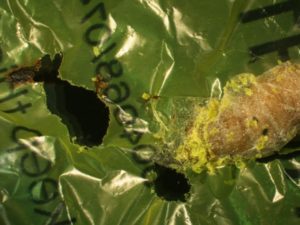A Spanish biologist and amateur beekeeper, Federica Bertocchini, has discovered a plastic-eating caterpillar that could help address global plastic pollution. Bertocchini accidentally discovered the caterpillar’s ability during routine beehive maintenance. Both she and her peers have since studied the phenomenon at the University of Cambridge. The scientific journal Current Biology published their findings in April 2017.
Bertocchini, of the Institute of Biomedicine and Biotechnology of Cantabria, made the discovery when removing caterpillars called wax worms from the honeycombs of a beehive. Placing them briefly on a plastic bag, Bertocchini noticed the caterpillars created holes in the bag. She contacted her peers at the University of Cambridge, Paolo Bombelli and Christopher J. Howe, to study this potentially significant discovery.
The Current Biology article confirms the findings of the group, which conducted a controlled experiment with 100 wax worms. They discovered that it took 40 minutes for the worms to create holes in a plastic bag. Each worm produced, on average, one to three holes per hour. The bag mass dropped by 40 micrograms during that time. Other researchers have previously discovered bacteria that can break down plastic, but only by 0.13 micrograms per day.

How do the caterpillars process plastic?
Chemical bonds in plastic usually resist biodegradation. But the researchers believe the wax worms can break down this plastic, or polyethylene, because their natural diet is beeswax. Honeycomb moths lay their eggs inside beehives and their young, wax worms, eat beeswax. This contains some of the same hydrocarbon compounds as plastic bags.
Howe confirmed it was important to determine if the wax worms possess a certain enzyme that digests the plastic or if they were just chewing the material into smaller pieces. Their tests showed that it was, in fact, a chemical or combination of chemicals within the worms that converted the plastic into a colorless and odorless liquid, ethylene glycol, used industrially to manufacture antifreeze and polyester fabrics. While this liquid is slightly toxic to humans, it is far less harmful than the current scale of plastic pollution.
Researchers do not yet know if the wax worms themselves or bacteria within their guts produce the chemical. A 2014 Chinese study found that caterpillars of the Indian meal moth, which also lives in beehives, could digest polyethylene thanks to two species of gut bacteria.
The next step is to identify the chemical that’s breaking the plastic’s bonds. If researchers can isolate the enzyme, the gene that controls it may be obtained and inserted into bacteria to degrade plastics. While wax worms are already cultivated for fishing bait, it would be easier to cultivate bacteria on a large scale to tackle global plastic pollution.
The plastic problem
We produce about 88 million tons of plastic globally each year, including 500 billion single-use plastic bags alone. These plastics do not naturally biodegrade. Instead, sunlight turns them into microplastics, which pollute the ocean and eventually enter the human food chain. Sea turtles and sperm whales mistake floating plastic bags for jellyfish and squid and eat them. In January 2016, 29 sperm whales stranded on shores around the North Sea. Their stomachs were filled with plastic debris, and they likely died from starvation due to gut blockages.
While this discovery of a plastic-eating caterpillar does hold promise when it comes to addressing the global plastic problem, Howe says it could be several years until cultivating the bacteria is possible. Bertocchini urges people to reduce plastic usage in the first place.
“We are planning to implement this finding into a viable way to get rid of plastic waste, working towards a solution to save our oceans, rivers, and all the environment from the unavoidable consequences of plastic accumulation,” she says.
“However, we should not feel justified to dump polyethylene deliberately in our environment just because we now know how to biodegrade it.

